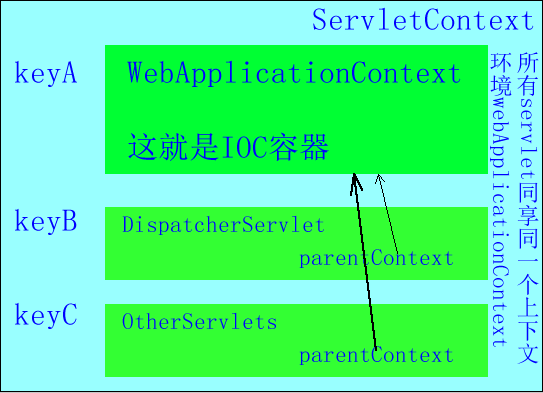一、先说ServletContext
javaee标准规定了,servlet容器需要在应用项目启动时,给应用项目初始化一个ServletContext作为公共环境容器存放公共信息。ServletContext中的信息都是由容器提供的。
举例:
<context-param> <param-name>key</param-name> <param-value>value123</param-value> </context-param> <listener> <listener-class>com.brolanda.contextlistener.listener.ContextListenerTest</listener-class> </listener>
package com.brolanda.contextlistener.listener; import javax.servlet.ServletContext; import javax.servlet.ServletContextEvent; import javax.servlet.ServletContextListener; public class ContextListenerTest implements ServletContextListener { public void contextDestroyed(ServletContextEvent event) { System.out.println("*************destroy ContextListener*************"); } @SuppressWarnings("unused") public void contextInitialized(ServletContextEvent event) { System.out.println("*************init ContextListener*************"); ServletContext servletContext = event.getServletContext(); System.out.println("key:"+servletContext.getInitParameter("key")); } }
执行流程:
web.xml在<context-param></context-param>标签中声明应用范围内的初始化参数
3.容器将<context-param></context-param>转化为键值对,并交给ServletContext.
5.在监听中会有contextInitialized(ServletContextEvent event)初始化方法
“context-param的值” = ServletContext.getInitParameter("context-param的键");
<init-param> <param-name>param1</param-name> <param-value>avalible in servlet init()</param-value> </init-param>
二、spring上下文容器配置
spring为我们提供了实现ServletContextListener接口的上下文初始化监听器:org.springframework.web.context.ContextLoaderListener
spring为我们提供的IOC容器,需要我们指定容器的配置文件,然后由该监听器初始化并创建该容器。要求你指定配置文件的地址及文件名称,一定要使用:contextConfigLocation作为参数名称。
<context-param> <param-name>contextConfigLocation</param-name> <param-value>/WEB-INF/applicationContext.xml,/WEB-INF/action-servlet.xml,/WEB-INF/jason-servlet.xml</param-value> </context-param> <listener> <listener-class>org.springframework.web.context.ContextLoaderListener</listener-class> </listener>
该监听器,默认读取/WEB-INF/下的applicationContext.xml文件。但是通过context-param指定配置文件路径后,便会去你指定的路径下读取对应的配置文件,并进行初始化。
三、spring上下文容器配置后,初始化了什么?
既然,ServletContext是由Servlet容器初始化的,那spring的ContextLoaderListener又做了什么初始化呢?

四、spring配置时:<context:exclude-filter>的使用原因,为什么在applicationContext.xml中排除controller,而在spring-mvc.xml中incloud这个controller
<context:component-scan base-package="com.linkage.edumanage"> <context:exclude-filter expression="org.springframework.stereotype.Controller" type="annotation" /> </context:component-scan>
<context:component-scan base-package="com.brolanda.cloud" use-default-filters="false"> <context:include-filter expression="org.springframework.stereotype.Controller" type="annotation" /> </context:component-scan>